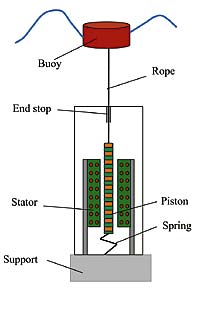





Published on Feb 14, 2025
The WEC is a new, highly efficient technology that harnesses the immense, renewable energy contained in ocean waves. Its unique ability to extract and convert energy from both the rising and falling of waves, represents a technological breakthrough. A wave energy conversion apparatus comprises at least two devices , each comprising a surface float , at least one of the surface floats being rigidly attached to a submerged body .
The movement between the at least two devices preferably effects an energy generation which is harnessed by the linkages.
The apparatus may also include mooring systems that maintain the complete apparatus in a position that is consistent with statutory requirements and not significantly inhibit its efficient operation.
Today more than 80 per cent of the world’s electric power production comes from fossil-fuelled plants. As the demand for electricity is forecasted to increase, there is an urgent need to find new methods to extract electric energy from renewable sources. Renewable electric energy supply is today one of the highest priorities in many parts of the world.
The Kyoto declaration 1997 and the last agreement at Marrakech 2002 are significant proof of this. Both the EU and the US have set their targets on future greenhouse emissions. Ocean waves represent a vast unexplored source of renewable energy. The wave energy potential in the EU has been estimated conservatively as 120–190 TWh/year offshore and an additional 34–46 TWh/year at near shore locations.
Linear generators for wave power conversion have previously been considered but where concluded as impossible, since low velocities were believed to give too slow flux changes and thereby large and expensive electromagnetic converters. However, renewed activities has been reported from England and the Netherlands . Furthermore, recent electromagnetic simulations, revile a neglected opportunity.
We work with a concept that combines Faraday's law of induction, Newton 's laws of motion, the even older principle of Archimedes with relative recent advancement in materials technology. In the spirit of minimizing mechanics by adapting generator to wave motion a design with a buoy absorbing ocean wave energy at the surface driving a linear generator at the sea floor is studied as in fig 1
The rising and falling of the waves off shore causes the buoy to move freely up and down.
The resultant mechanical stroking drives the electrical generator.
The generated AC power is converted into high voltage DC and transmitted ashore via an underwater power cable.

Figure 1. The wave energy converter (WEC) consists of a buoy coupled directly to the rotor of a linear generator by a rope. The tension of the rope is maintained with a spring pulling the rotor downwards. The rotor will move up and down at approximately the same speed as the wave. The linear generator has a uniquely low pole height and generates electricity at low wave amplitudes and slow wave speeds.
Wave energy is directly converted into electricity by a linear generator consisting of insulated conductors; NdFeB permanent magnet and steel of different quality like electroplate and construction steel. Detailed modelling and simulations, as opposed to the traditional rule of thumb estimates, with a full account of design in full physics simulation gives detailed data on performance, as illustrated in Figure 2.
The buoy, which drives the linear generator, can be built from different materials having good resistance to corrosion and which can withstand high stress caused by the ocean waves and in different forms.
However, a cylindrical shape is preferred as a uni-directional point absorber is desired. Buoy dynamics and its behaviours during ocean wave exposure have been described elsewhere. A buoy connected with a stiff rope will drive the generator piston as the wave is rising. When the wave subsides a spring that has stored energy mechanically will drive the generator. Thus allowing for generation of electricity during both up and down travel. Environmental Advantages
Wave energy provides power without creating waste. It does not threaten marine life or the environment with spillage, CO2 emissions, or pollution from radiation and particle matter. There is no noise pollution or visibility of the system from the shore. In fact, it helps reduce shoreline erosion. Comprehensive, independent environmental assessments have been performed on wecs. They have addressed all aspects of potential impact on the environment, vegetation, fish and mammals, and have resulted in findings of no significant impact.
The table below shows OPT's wave energy is a concentrated, predictable form of energy, and has a high availability (percentage of time the system is producing energy).
The footprint of a 100MW conventional power plant superstructure, including surrounding grounds, fuel unloading areas, waste settling ponds, and additional facilities can require up to 2 square miles of valuable real estate. A comparable wec power plant would occupy less than 1 square mile of unused ocean surface out of sight from the shore.
1. http://www.telegraph.co.uk/news/.html
2. http://www.shipgaz.com
3. http://www.wavegen.com
4. http://www.opt.com
5. http://www.waveenergyextractors.com
| Are you interested in this topic.Then mail to us immediately to get the full report.
email :- contactv2@gmail.com |